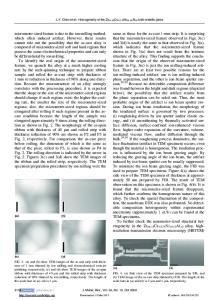Study of The Quasicrystal Formation in Zr 46.8 Ti 8.2 Cu 7.5 Ni 10 Be 27.5 Bulk Metallic Glass
- PDF / 1,402,669 Bytes
- 6 Pages / 612 x 792 pts (letter) Page_size
- 50 Downloads / 266 Views
CC10.11.1
Study of The Quasicrystal Formation in Zr46.8Ti8.2Cu7.5Ni10Be27.5 Bulk Metallic Glass J.L. Soubeyroux, J.M. Pelletier1, B. Van de Moortèle1, T. Epicier1 Laboratoire de Cristallographie / CRETA / CNRS, 25 avenue des Martyrs, 38042 Grenoble, France 1 GEMPPM, INSA Lyon, bâtiment B. Pascal, 20 Avenue A.Einstein, 69621 Villeurbanne, France ABSTRACT The formation of the primary crystals appearing during isothermal annealing of the Zr46.8Ti8.2Cu7.5Ni10Be27.5 (Vit4) bulk metallic glasses has been studied by in-situ neutron diffraction, DSC, high resolution TEM and electron diffraction. We have evidenced that the primary phase appearing on the isothermal plateau at 620 K is quasicrystalline and is beryllium free. Moreover, we have prepared an alloy with the composition determined by EDX (without beryllium), and studied the formation of quasicrystals in this alloy. A comparison is done between the quasicrystalline phases appearing during the annealing of Vit4 and the quasicrystals prepared without beryllium in an amorphous alloy prepared by melt spinning. In particular they have the same intensities and peak positions in the diffraction studies. INTRODUCTION Bulk metallic glasses have attract a lot a attention this last decade, and among them the family ZrTiCuNiBe presents the best performances in matter of glass forming ability over cost [1]. However these phases are metastable and several studies deal with the inherent instability of the amorphous state, as this instability modifies the mechanical properties. In particular when these alloys are heated in the supercooled liquid region, a decomposition appears and is different for each alloy composition. The phase separation process for example depends on the Be content. In the alloy Zr41.2Ti13.8Cu12.5Ni10Be22.5 (called Vit1), Löffler et al. [2] reported a pathway where phase separation appears first, then polymorph crystallisation appears as nanocrystallisation. For the alloy Zr46.25Ti8.25Cu7.5Ni10Be27.5 (called Vit4), no phase separation appears prior to crystallization and Wanderka et al. [3,4] reported that a quasicrystalline phase is formed in the first step of crystallization, followed by a decomposition of this phase at higher temperatures. Formation of quasicrystals during devitrification of metallic glasses has been also observed in rapidly quenched alloys Pd60U20Si20 [5], Ti45Zr38Ni17 [6], or bulk metallic glasses Zr65Ni10Ag10Al7.5Ni7.5 [7] or ZrNiCuAl [8,9]. In all these systems, the phases appearing have been investigated by X-ray diffraction and TEM observations, but the crystallisation sequence is not given precisely. The present work is focussed on the formation of quasicrystals in the Vit4 alloy during isothermal annealing by using powder neutron diffraction (PND), high resolution transmission electron microscopy (HRTEM) and transmission electron microscopy coupled with Energy-Dispersive X-ray spectroscopy and Electron Energy Loss Spectroscopy (TEM/EDX/EELS). EXPERIMENTAL DETAILS Bulk metallic glasses Zr46.25Ti8.25Cu7.5Ni10Be27.5 samples were prepar
Data Loading...











